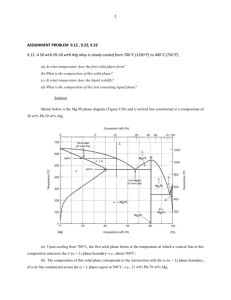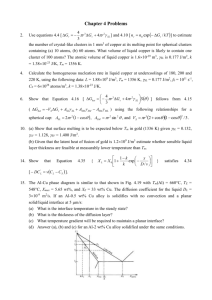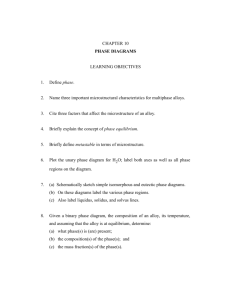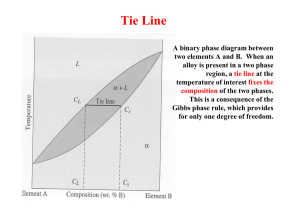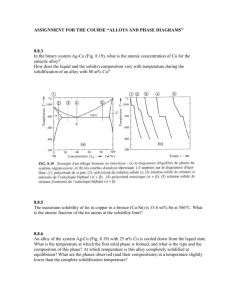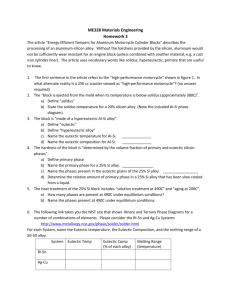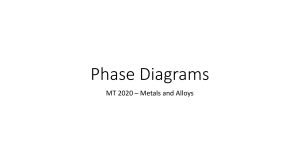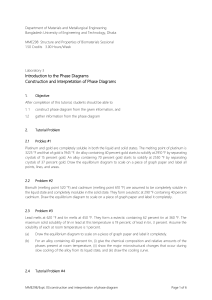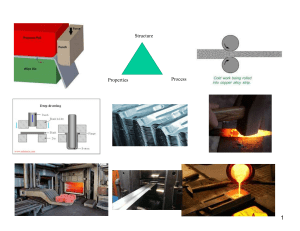Materials Science Assignment Problems: Phase Diagrams
advertisement
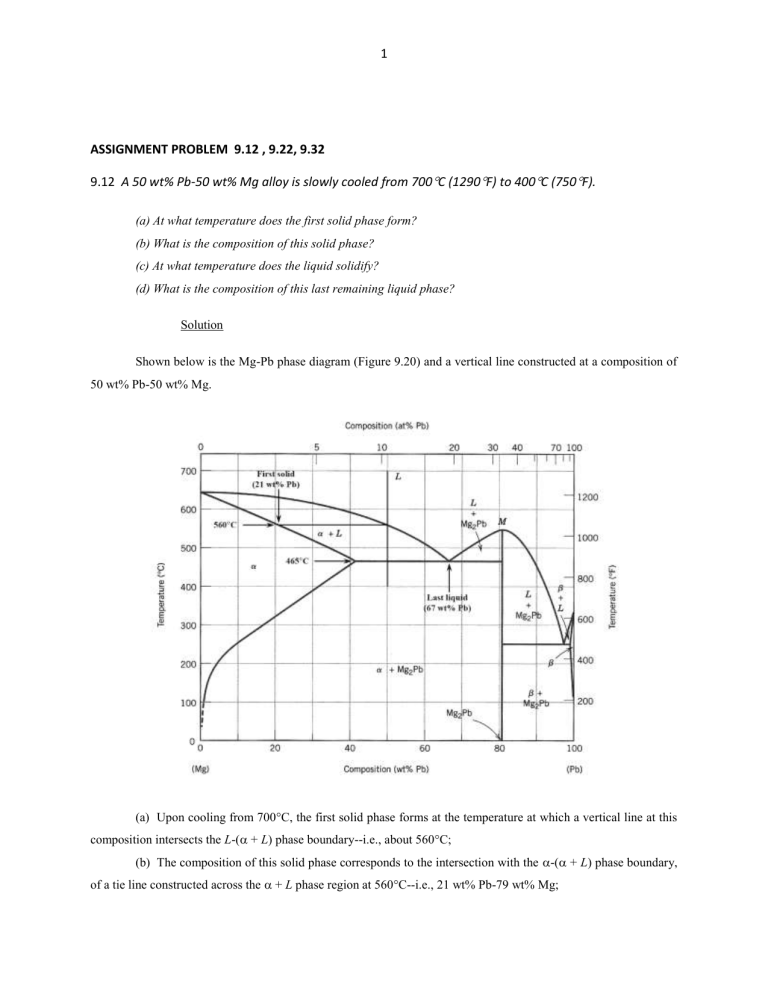
1 ASSIGNMENT PROBLEM 9.12 , 9.22, 9.32 9.12 A 50 wt% Pb-50 wt% Mg alloy is slowly cooled from 700C (1290F) to 400C (750F). (a) At what temperature does the first solid phase form? (b) What is the composition of this solid phase? (c) At what temperature does the liquid solidify? (d) What is the composition of this last remaining liquid phase? Solution Shown below is the Mg-Pb phase diagram (Figure 9.20) and a vertical line constructed at a composition of 50 wt% Pb-50 wt% Mg. (a) Upon cooling from 700C, the first solid phase forms at the temperature at which a vertical line at this composition intersects the L-( + L) phase boundary--i.e., about 560C; (b) The composition of this solid phase corresponds to the intersection with the -( + L) phase boundary, of a tie line constructed across the + L phase region at 560C--i.e., 21 wt% Pb-79 wt% Mg; 2 (c) Complete solidification of the alloy occurs at the intersection of this same vertical line at 50 wt% Pb with the eutectic isotherm--i.e., about 465C; (d) The composition of the last liquid phase remaining prior to complete solidification corresponds to the eutectic composition--i.e., about 67 wt% Pb-33 wt% Mg. 9.22 For 11.20 kg of a magnesium-lead alloy of composition 30 wt% Pb-70 wt% Mg, is it possible, at equilibrium, to have α and Mg2Pb phases having respective masses of 7.39 kg and 3.81 kg? If so, what will be the approximate temperature of the alloy? If such an alloy is not possible, explain why. Solution Yes, it is possible to have a 30 wt% Pb-70 wt% Mg alloy which has masses of 7.39 kg and 3.81 kg for the and Mg2Pb phases, respectively. In order to demonstrate this, it is first necessary to determine the mass fraction of each phase as follows: W = m 7.39 kg = = 0.66 m mMg2Pb 7.39 kg 3.81 kg WMg2Pb = 1.00 0.66 = 0.34 Now, if we apply the lever rule expression for W W = CMg2Pb C0 CMg2Pb C Since the Mg2Pb phase exists only at 81 wt% Pb, and C0 = 30 wt% Pb W = 0.66 = 81 30 81 C Solving for C from this expression yields C = 3.7 wt% Pb. The position along the + Mg2Pb) phase boundary of Figure 9.20 corresponding to this composition is approximately 190C. 3 9.32 For a copper-silver alloy of composition 25 wt% Ag-75 wt% Cu and at 775C (1425F) do the following: (a) Determine the mass fractions of α and β phases. (b) Determine the mass fractions of primary α and eutectic microconstituents. (c) Determine the mass fraction of eutectic α. Solution (a) This portion of the problem asks that we determine the mass fractions of and phases for an 25 wt% Ag-75 wt% Cu alloy (at 775C). In order to do this it is necessary to employ the lever rule using a tie line that extends entirely across the + phase field. From Figure 9.7 and at 775C, C = 8.0 wt% Ag, C = 91.2 wt% Ag, and Ceutectic = 71.9 wt% Sn. Therefore, the two lever-rule expressions are as follows: W = C C0 91.2 25 = = 0.796 C C 91.2 8.0 W = C0 C 25 8.0 = = 0.204 C C 91.2 8.0 (b) Now it is necessary to determine the mass fractions of primary and eutectic microconstituents for this same alloy. This requires us to utilize the lever rule and a tie line that extends from the maximum solubility of Ag in the phase at 775C (i.e., 8.0 wt% Ag) to the eutectic composition (71.9 wt% Ag). Thus W' = CeutecticŹ C0 71.9 25 = = 0.734 CeutecticŹ C 71.9 8.0 We = C0 C 25 8.0 = = 0.266 Ceutectic C 71.9 8.0 (c) And, finally, we are asked to compute the mass fraction of eutectic , We. This quantity is simply the difference between the mass fractions of total and primary as We = W – W' = 0.796 – 0.734 = 0.062 4 5
